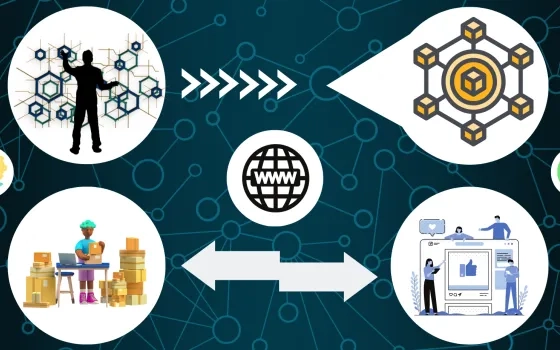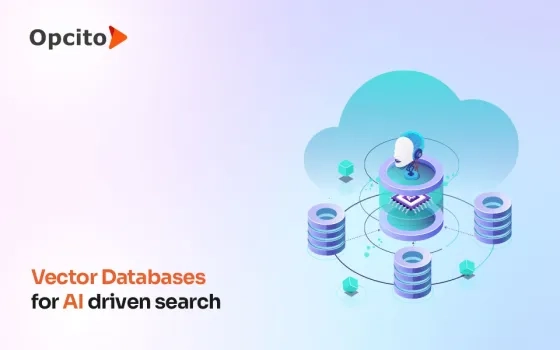What is Web 3.0?
There’s this buzz about web3. Many organizations are imagining and creating the next generation of the world wide web; a lot of venture money has been poured into this space, and a lot more will flow in. At the heart of it all, the web3 concept revolves around a decentralized web where users will control their data, businesses will engage with customers with trust and transparency, platform utility will be based on value addition and not on control over data.
Before we go further into web3, let’s understand a bit about the evolution of web1 and web2.
Web1… how it all started:
Web1 was the first generation of the internet, a.k.a. world wide web, which originated in the 1990s. Web1 was based on open protocols established by the community, which connected businesses and people. Web1 was made up of static read-only web pages (business websites) and email communications (Hotmail, AOL Mail, etc.). The first generation of internet search engines (Yahoo, AltaVista, etc.) were born to help users navigate the web1 internet, creating a map of the web pages and helping discover web content.
Web1 helped businesses showcase their products and services, and publish as much information as possible publicly. Users had to voluntarily choose to visit a business' website to consume any content. The search engine worked as per user preferences and could guide their actions by ranking and displaying web content, and of course it led to paid content and online advertising. Businesses found online advertising a valuable service and paid to build visibility.
What started as extremely convenient services became advertising platforms. Very little personal data was collected, and the limited personalization was with regard to web search content and advertisements.
Visualize this in the physical world:
One morning, you found a leaflet on your doorstep about a wine festival in the valley. You decided to drive through the route, visit a few vineyards, and pick up some good reds for your collection. You stopped at a gas station enroute to ask the locals for recommendations on the best vineyards. They promptly made suggestions, which also included a few vineyards that paid them for referrals.
That used to be web1.
Web2... the current version of the web:
Web1 evolved into web2 in the 2000s and 2010s, a more social and interactive internet, with the advent of platforms for social media (Facebook, LinkedIn, Instagram, etc.), instant communications (WhatsApp, etc.), cloud storage (DropBox, GoogleDrive, etc.), digital streaming media (Netflix, YouTube, Spotify, etc.), online marketplaces (Amazon, Alibaba, Expedia, etc.), service aggregators (Uber, DoorDash, Ola, Zomato, etc.), online financial services (PayPal, CashApp, Revolut, Robinhood, PayTM, Zerodha, RazorPay, Ant Financial, etc.), connected devices (FitBit, Amazon Alexa, Ring, HKVision, etc.). Widespread adoption of smartphones (Apple, Android) and the availability of affordable internet services (AT&T, Verizon, Airtel, Jio, etc.) have brought exponential growth to these platforms. Internet search engines (Google) have become more universal and scaled, helping navigate the massive volumes of dynamic content; the endogenous search algorithms of the digital platforms have become sophisticated with the ability to deeply understand and influence user behavior.
Users have gained the ability to publish their own content and interact with the content of others, watch streaming digital content, shop for goods online, book instant services via aggregators, and conduct financial transactions in real-time.
Users are happily surrendering their personal data to use what appear to be free/ convenient services provided by these platforms, and platforms are profiting from user data. Additional data is being sourced from third parties to augment and profile users, for targeted advertisements and personalization of services. The potential of the internet has become concentrated, and power has become centralized with these platforms. Users are left with little knowledge or control of their personal data usage; and a sense of invasion of privacy prevails. Businesses have become highly dependent on such platforms to serve customers and grow, and they have to play by the rules of these platforms.
Visualize this in the physical world:
You are walking down a crowded bazaar street in a small touristy town in the Mediterranean. Hawkers are presenting products that they believe you need or want, based on your visual profile. But there are some hawkers who seem to have gathered very personal information about you, such as your age, residence, clothing preferences, family and connections, shopping history, financials, and are using that information to hustle products. One of them says, “Hey Mister, you didn’t end up going to the fancy restaurant that you were checking out last night, so you must have saved a lot of money; why don’t you buy this nice hat, which is the same as the one you were checking out in your hometown?; I’m sure your 16-year-old will love it.”
Does that feel like personalization or an intrusion into your personal space? That’s the predicament of web2.
In such a competitive bazaar, hawkers are willing to pay a premium to the middlemen who provide such user information which'll help them outplay the competition. Hawkers have changed/ adapted their business around data/ services offered by middlemen, and the middlemen have become powerful intermediaries, while the hawkers have become highly dependent on the intermediary services.
Does it feel like the intermediaries have become far too powerful and are acting as gatekeepers to the information economy? That's the limitation of web2.
Web3... the promising future:
Web3 is a new iteration of world wide web which offers a whole new level of hyper-personalized digital experiences using permissioned data and decentralized networks.
Several factors are helping the advancement of the web3 concept forward: users are becoming increasingly aware and sensitive about their data privacy; authorities are developing policies and frameworks to push digital platforms towards user data protection; authorities are also pushing to break the dominance of big platform players and make the market more open, competitive, interoperable and portable; advancement and adoption of innovative blockchain and crypto technologies; and huge investments being made into web3 projects.
Web3, which is work in progress, will probably take several years to play out. Web3 will be a layer over web1 and web2; while all three generations will co-exist, businesses will be compelled to transition to web3 digital services.
We can expect web3 to make it possible for users to sign into digital platforms anonymously or pseudonymously, while also selectively disclosing personal data such as demographics, preferences, transaction history, and financials to get the level of personalization desired by the user. Some of the services in the web3 world, just like in the web2 world, especially those relating to regulated industries or procurement of restricted goods or services (such as financial services, arms, drugs, liquor, etc.), may require stricter customer verification/ know-your-customer (KYC) controls, which could also be achieved via digital ID wallets or tokens validated by authorized trust entities or government agencies. We can also envisage core applications on mobile devices that’ll provide an additional layer of data anonymization and protection.
The established digital platforms will be forced to pivot, relook at their business model, rethink personalization, and implement a transparent and consent-driven framework for their services. Digital platforms will need to adopt open standards, integrate and interoperate with the network, and support portability.
Digital platforms may look to incentivize users with additional discounts or reward points if they opt-in to share their data; as such data is valuable for the platform to perform behavioral analytics, and useful for businesses to run targeted campaigns. Businesses will thrive on the open network and focus on providing seamless experiences to customers using multiple platforms. Users will choose to stay on digital platforms not because their data is held captive, but because they see true value addition.
Visualize this in the physical world:
You walk into an accessories shop; as you enter, you ask your assistant to hand over a file with selected information about yourself, your preferences, buying habits, lifestyle, and give them permission to study and use that information to hyper-personalize your experience in the store for the next 60 minutes. You introduce yourself as Miss. Mysterious, tell them you are buying a gift for yourself for your birthday within a budget of $500. Your file has information on your previous purchases, brands and products you prefer, etc. Based on the above, the store manager recommends a branded leather bag that is of a color very different from the previous purchases, which also happens to be on sale at $499. The store manager offers an additional 5% discount if you allow them to keep your information for profiling, analytics and future campaigns, which you politely decline. As you complete the purchase and walk out the store, your assistant collects your file, and adds the receipt to the file.
That’s it. No digging through information on your partner or kids, no sniffing through your credit card transactions to understand your potential, no seeking information on which other stores you visited and which other products you checked out, no asking where you live, no creating profiles of you and your family, no up-selling or cross-selling based on anything other than information you shared.
This is an example of information accessed with consent, hyper-personalization with transparent data usage, transaction conducted with full trust, data kept in an interoperable and portable format, control exerted by its rightful owner, and facilitated by value-adding intermediaries. And that’s web3!
Should we feel excited about web3?
Yes! Web3 will create an open and fair network which will thrive on collaboration, competition, and innovation. And web3 will bring about the much-needed balance between data privacy and personalization, giving users firm control over how their data is used to personalize products and services.
















